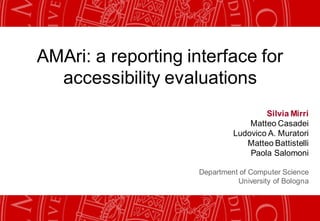Mirri w4a2012 webchallenge
- 1. AMAri: a reporting interface for accessibility evaluations Silvia Mirri Matteo Casadei Ludovico A. Muratori Matteo Battistelli Paola Salomoni Department of Computer Science University of Bologna
- 2. Summary ’é¦Introduction ’é¦AMAri Issues ’é¦Demo ’é¦Conclusions W4A 2012 ŌĆō April 16th&17th, 2012 - Lyon, France 2
- 3. Introduction Accessibility evaluation + accessibility monitoring = Huge amount of data How can we manage and exploit such data? AMAri (Accessibility Monitoring Application Reporting Interface) produces accessible and personalized outputs (graphics and tables) on the basis of Web pages accessibility evaluations W4A 2012 ŌĆō April 16th&17th, 2012 - Lyon, France 3
- 4. AMAri Issues ŌĆó AMAri ŌĆó Supports authors/editors in accessibility processes ŌĆó Is open source, Web based, based on PHP, HTML, CSS and AJAX ŌĆó Provides reports as graphics and tables ŌĆó Stores data by means of an accessibility monitoring system ŌĆó AMAri user defines a set of personalized views W4A 2012 ŌĆō April 16th&17th, 2012 - Lyon, France 4
- 5. Creating widgets ŌĆó Each widget 1. represents the whole data set or a part of it 2. refers to a single Web site or to a group of them 3. shows data focusing on one or two dimensions (among: time, URLs, guidelines, geographic area, chart type) 4. is statically computed and stored or shows everyday changes in the accessibility status W4A 2012 ŌĆō April 16th&17th, 2012 - Lyon, France 5
- 6. Pie chart W4A 2012 ŌĆō April 16th&17th, 2012 - Lyon, France 6
- 7. Timeline W4A 2012 ŌĆō April 16th&17th, 2012 - Lyon, France 7
- 8. Density chart W4A 2012 ŌĆō April 16th&17th, 2012 - Lyon, France 8
- 9. Conclusion AMAri ŌĆó supports authors/editors involved in the implementation and assessment of accessible Web sites ŌĆó Exploits a huge amount of data resulting by accessibility evaluations and monitoring activities ŌĆó Supports users in creating their own points of view about gathered data, focusing on 1 or 2 dimensions (among: temporal dimension, single URL or group of URLs, set of guidelines or requirements, geographic area, char type W4A 2012 ŌĆō April 16th&17th, 2012 - Lyon, France 9
- 10. Contacts ’é¦ Thank you for your attention! ’é¦ For further information: ’é¦ silvia.mirri@unibo.it W4A 2012 ŌĆō April 16th&17th, 2012 - Lyon, France 10









